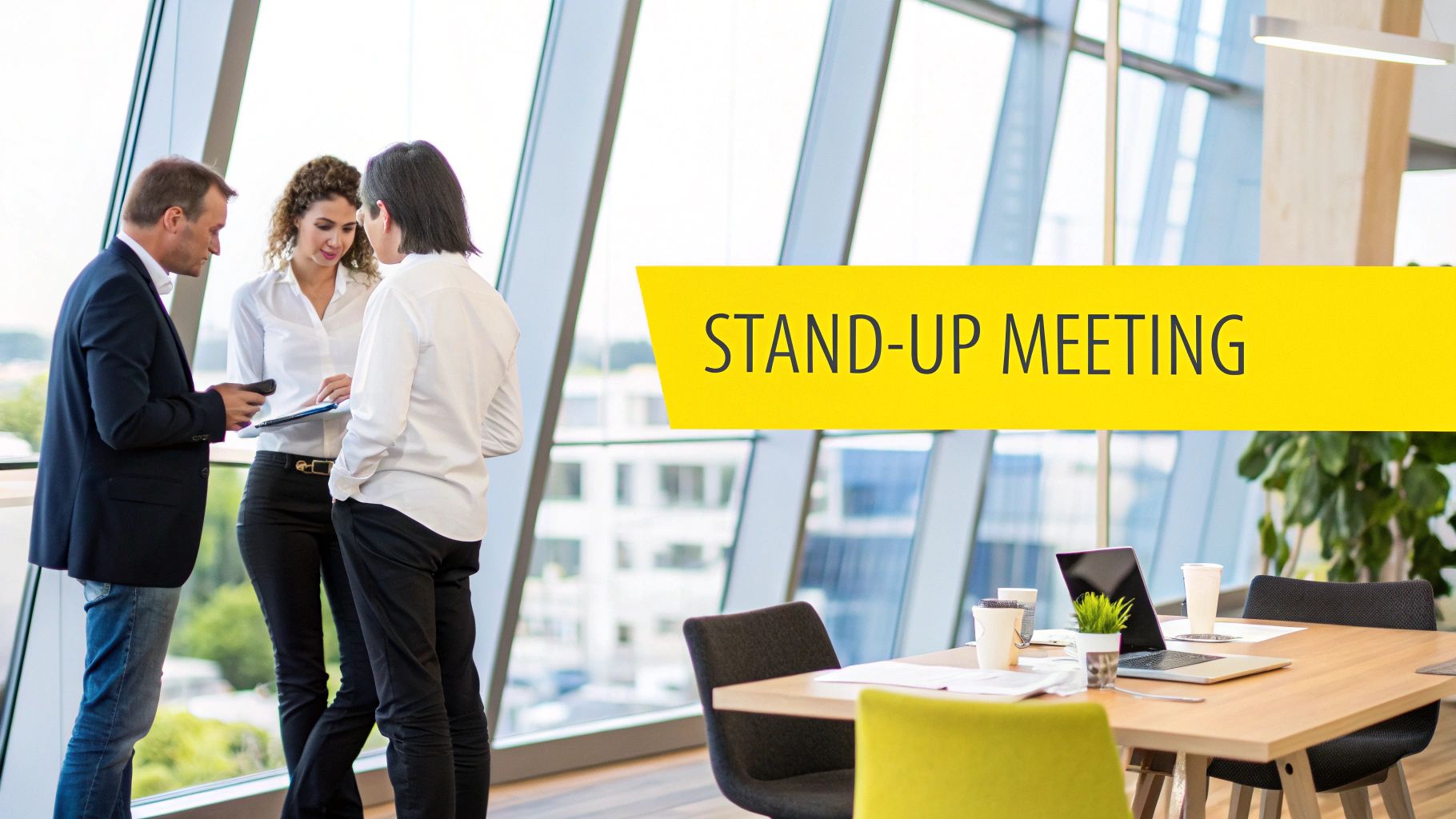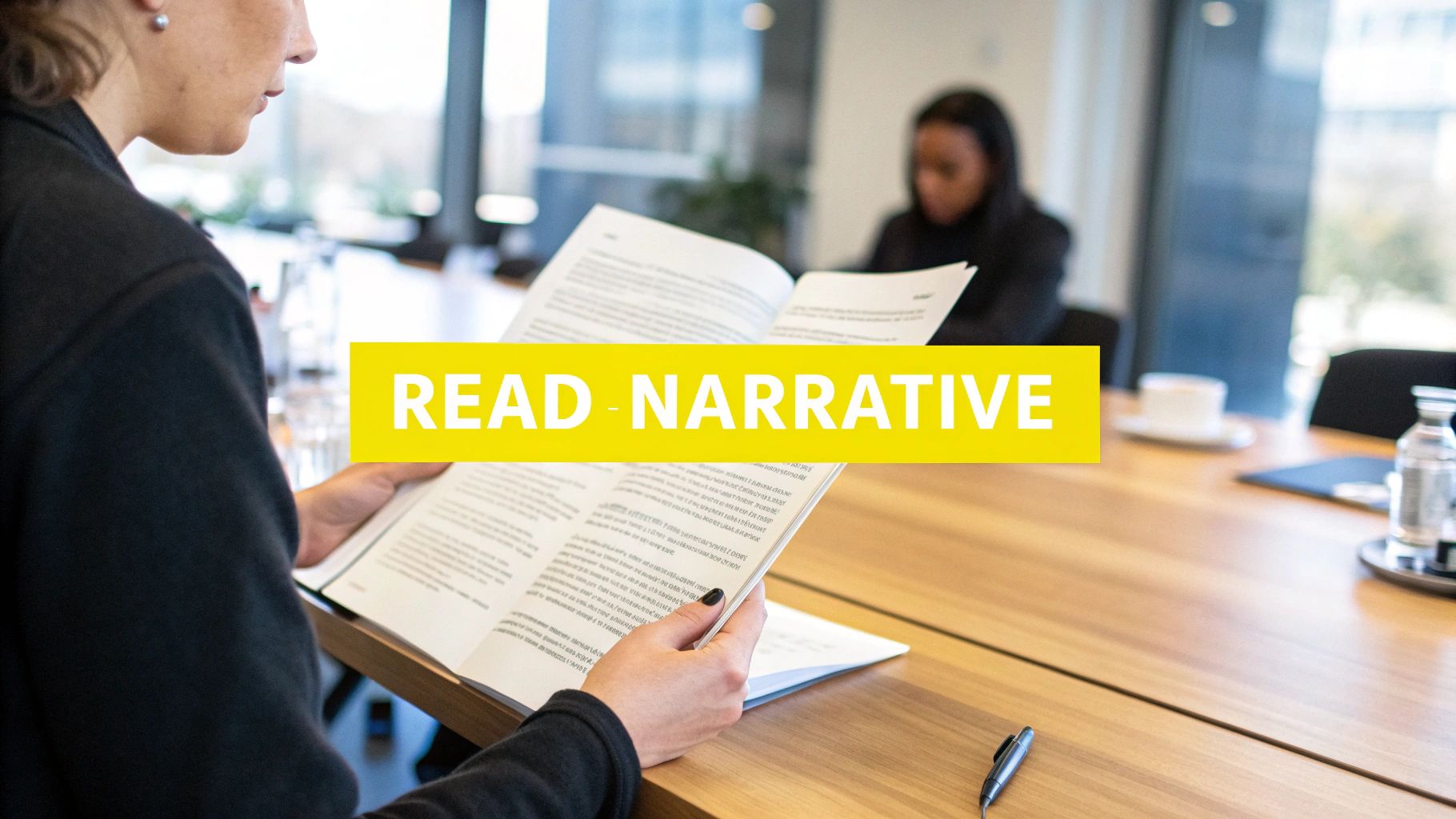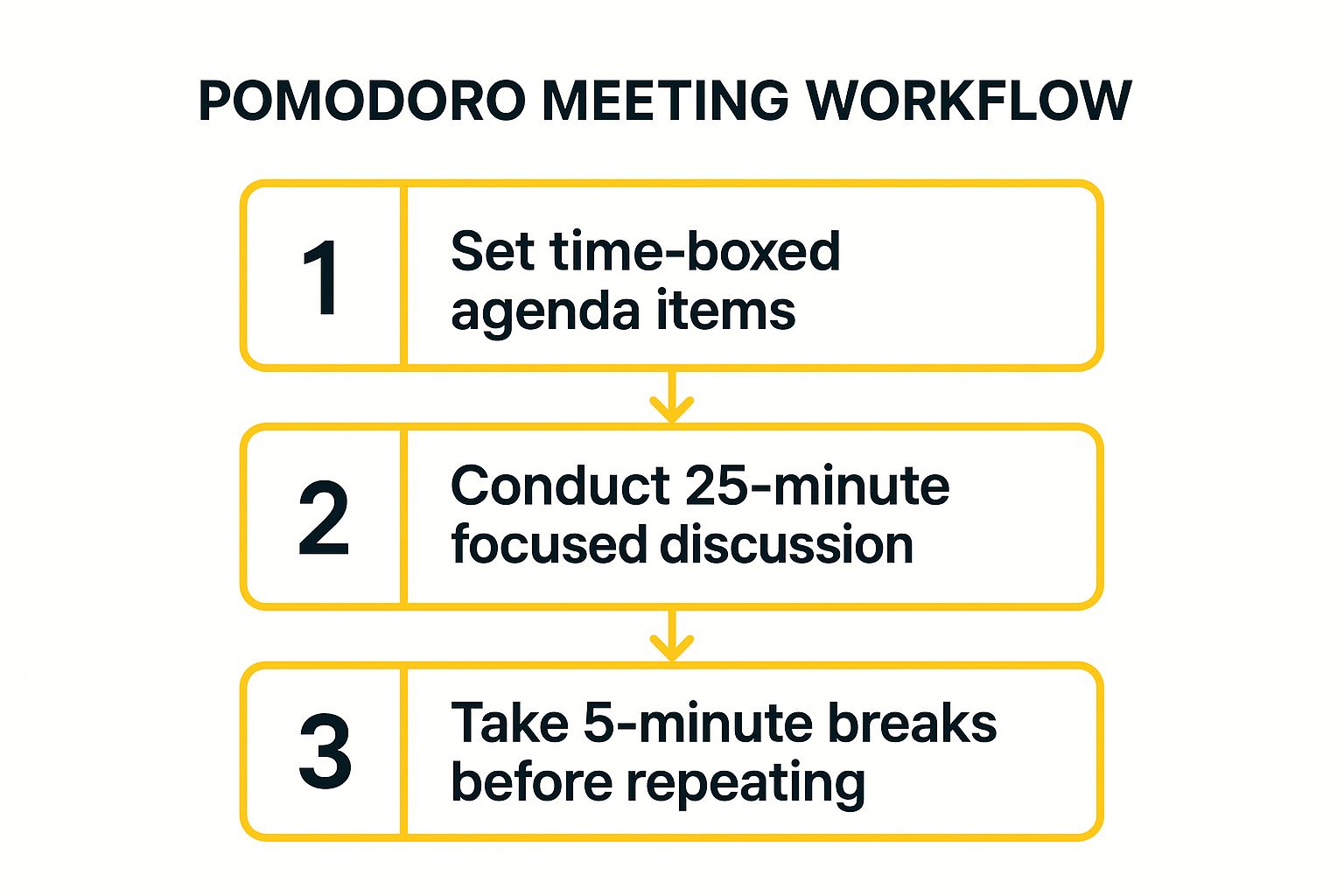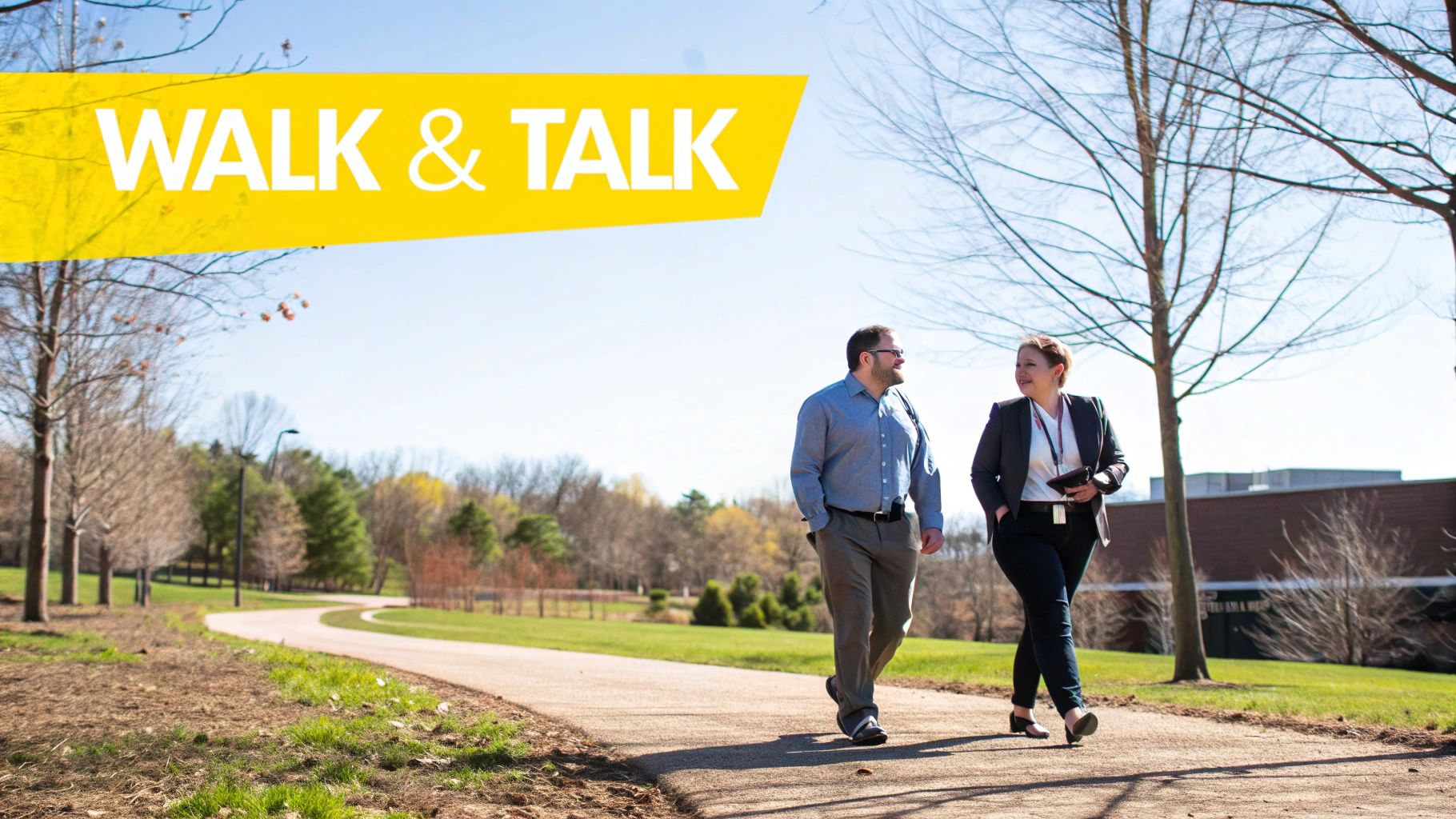Meetings are the default setting for collaboration, yet endless back-to-back sessions often drain productivity more than they boost it. The average professional spends over 21 hours a week in meetings, a number that has tripled since early 2020. This constant demand on our time fragments focus, stalls deep work, and leads to widespread ‘meeting fatigue.’ But what if we could change the default? What if meetings became shorter, more focused, and consistently productive?
The solution isn’t to eliminate meetings entirely, but to transform them. This roundup explores eight powerful, battle-tested methodologies from the world’s most innovative companies and agile teams. From Amazon’s narrative-driven approach to the strategic use of time-boxing, these strategies provide a clear roadmap to reduce meeting time. By implementing these techniques, you can enhance decision-making and give your team its most valuable resource back: time to execute.
This guide moves beyond generic advice to offer specific, actionable frameworks you can implement immediately. Prepare to shift your team’s culture from endless discussion to decisive action and fundamentally change your relationship with the calendar. You will learn how to make every minute count, ensuring that when your team does gather, it’s for a clear, high-value purpose.
1. The 15-Minute Stand-Up Meeting
A cornerstone of Agile methodology, the 15-minute stand-up meeting is a powerful tool designed to drastically reduce meeting time by enforcing brevity and focus. This daily, time-boxed session brings the team together to sync up on progress, identify immediate blockers, and align on the day’s priorities. The core principle is simple: participants remain standing, a subtle physical cue that encourages concise updates and discourages lengthy discussions.

Pioneered by Scrum creators Jeff Sutherland and Ken Schwaber, this format is used by hyper-efficient teams at companies like Spotify and Microsoft. Its effectiveness lies in a structured, repeatable agenda. Each team member quickly answers three key questions:
- What did I accomplish yesterday?
- What will I work on today?
- What obstacles are in my way?
This structure keeps the focus on action and accountability, not open-ended debate.
How to Implement the Stand-Up
To make this meeting a success, discipline is essential. The goal is rapid-fire communication, not in-depth problem-solving.
- Be Punctual: Start the meeting on time, every time, even if some members are not present. This reinforces the importance of the meeting.
- Use a Timer: Display a visible 15-minute countdown timer for everyone to see. This creates a shared sense of urgency.
- Create a “Parking Lot”: Any complex topic or discussion that requires more than a minute should be “parked.” Note it on a whiteboard or digital document for a follow-up meeting with only the necessary people.
- Keep Teams Small: This format works best with teams of 3 to 7 people to ensure everyone has time to speak without rushing.
By adhering to these rules, teams can replace a meandering hour-long status update with a highly efficient 15-minute sync. To get started with a structured format, you can find a helpful Scrum meeting agenda template on resolution.de.
2. The Amazon 6-Page Narrative
Championed by Jeff Bezos, the Amazon 6-Page Narrative is a revolutionary approach designed to reduce meeting time by replacing slide decks with deep, thoughtful prose. The methodology forces participants to spend the first 15 to 30 minutes of a meeting in structured silence, silently reading a detailed, six-page document. This ensures everyone enters the discussion with the same comprehensive context, eliminating the need for a presenter to walk through bullet points.

Famously used for all senior leadership and strategic planning meetings at Amazon, this technique has been documented by Brad Stone in “The Everything Store” and adopted by forward-thinking companies like Buffer and Shopify. The goal is to elevate the quality of thought and discussion. Writing a full narrative memo forces the author to clarify their ideas, anticipate questions, and present a coherent argument, which is far more rigorous than creating a PowerPoint.
How to Implement the 6-Page Narrative
Adopting this method requires a shift from presentation skills to strong writing and critical thinking. The silent reading period is non-negotiable and is the key to its success.
- Structure the Narrative: The document should be a well-structured memo, not a stream of consciousness. Include an executive summary in the first paragraph to convey the main point immediately.
- Allocate Reading Time: For complex topics, schedule at least 20 to 30 minutes for silent reading. This allows attendees to digest the information and prepare thoughtful follow-up questions.
- Enforce Formatting Standards: Maintain consistency by using a standard format, such as Times New Roman 11-point font, to keep the focus on the content, not the design.
- Practice Writing: Encourage team members to practice this form of writing. It is a skill that develops over time and requires feedback and iteration.
By dedicating the initial part of a meeting to focused reading, teams can move directly to high-level, informed discussion. For those interested in the philosophy behind this, a great read is Jeff Bezos’s original memo on the topic, often shared on platforms like Medium.
3. Time-Boxing with the Pomodoro Technique
Applying the Pomodoro Technique to meetings transforms them from open-ended discussions into structured, high-focus sessions. This method, originally a personal productivity tool, helps reduce meeting time by breaking down a meeting into focused 25-minute intervals, known as “Pomodoros,” followed by short 5-minute breaks. This cyclical approach combats meeting fatigue and ensures that each agenda item receives dedicated, uninterrupted attention.
This strategy is highly effective for complex or creative meetings where sustained energy is crucial. Design thinking workshops at IDEO and marketing brainstorming sessions at HubSpot benefit from this structure, as it maintains momentum without causing burnout. The short, mandatory breaks allow attendees to recharge, check messages, or grab a coffee, returning to the next topic refreshed and ready to contribute their best ideas.
The infographic below illustrates the simple yet powerful workflow for a Pomodoro-style meeting.

This repeatable cycle of focused work and short rests ensures the meeting maintains a brisk, productive pace from start to finish.
How to Implement Pomodoro Meetings
Successfully using this technique requires discipline and a commitment to honoring the timer. The goal is to maximize focus during the sprints and fully disconnect during the breaks.
- Plan the Agenda in Boxes: Before the meeting, break down your agenda into topics that can realistically be covered in 25-minute segments. A 60-minute meeting might consist of two 25-minute Pomodoros with a 5-minute break in between.
- Use a Visible Timer: Display a large, visible timer for all participants, whether in-person or remote. This shared reference point reinforces the time constraint and keeps everyone aligned.
- Assign a Timekeeper: Rotate the role of a “timekeeper” who is responsible for starting and stopping the timer and announcing the breaks. This prevents the facilitator from having to constantly watch the clock.
- Use Breaks for Action Items: The 5-minute breaks are perfect for individuals to quickly review their notes and capture any personal action items or follow-up tasks without disrupting the group’s flow.
This method is championed by productivity experts like Cal Newport for its ability to facilitate “deep work” in a group setting. For a digital timer designed for this purpose, you can explore the Pomofocus web app, a simple and effective tool for both individuals and teams.
4. The Lightning Decision Jam (LDJ)
When you need to solve a complex problem without endless discussion, the Lightning Decision Jam (LDJ) is an invaluable technique to reduce meeting time. Developed by design agency AJ&Smart, this structured workshop compresses what could take weeks of debate into a focused 60- to 90-minute session. It guides a team from defining a problem to generating actionable solutions without any open, unstructured brainstorming.
This method was popularized by Jonathan Courtney of AJ&Smart and builds on principles from Jake Knapp’s Sprint methodology. It’s used by innovative companies like Slack for product development and startups like N26 for strategic planning. The core of the LDJ is a series of timed, silent exercises:
- Note-taking on what’s working and what isn’t.
- Prioritizing problems through dot voting.
- Reframing the top problem as a solvable challenge.
- Ideating solutions individually and silently.
- Voting on the most viable solutions.
- Deciding on concrete, actionable next steps.
This process ensures every voice is heard equally, preventing the loudest person from dominating the conversation.
How to Implement the LDJ
A successful LDJ requires a strong facilitator and clear ground rules. The goal is to move quickly and decisively through each step.
- Start with a Clear Problem: The session must begin with a well-defined problem statement or topic to ensure everyone is aligned.
- Assign Roles: Designate a facilitator to guide the process, a timekeeper to enforce strict time-boxing for each step, and a note-taker.
- Use Collaboration Tools: For remote teams, digital whiteboards like Miro or Mural are essential. Prepare a template in advance to save time.
- Follow Up Immediately: Send a summary of the decided-upon action items and owners within 24 hours to maintain momentum.
By replacing chaotic brainstorming with a disciplined, step-by-step process, the LDJ ensures your team leaves with a tangible plan. For facilitators looking for more structured methods, you can explore other powerful retrospective facilitation techniques on resolution.de.
5. The No-Agenda Meeting Elimination
A radical yet highly effective strategy to reduce meeting time is the “no agenda, no meeting” policy. This approach mandates that any meeting invitation must be accompanied by a clear, detailed agenda, typically shared 24 hours in advance. If an invitation lacks an agenda, it is automatically declined or cancelled, forcing organizers to be intentional and purposeful with their requests for others’ time. The core principle is that a meeting without a plan is just a conversation, not a productive work session.
This policy has been famously implemented by leaders like Drew Houston at Dropbox and is a common practice in high-stakes environments like consulting firms McKinsey & Company and remote-first pioneers like Zapier. Its power lies in shifting the default from “accept” to “question.” It forces the meeting organizer to justify the gathering by outlining specific goals, topics for discussion, and desired outcomes before consuming company resources.
How to Implement the No-Agenda Policy
Rolling out this policy requires commitment from leadership and clear communication. The goal is to build a culture of preparation, not to create bureaucratic hurdles.
- Create Agenda Templates: Develop simple, standardized templates for recurring meeting types (e.g., project kick-offs, decision-making sessions, brainstorming). This lowers the barrier to creating a good agenda.
- Include Time Allocations: Each agenda item should have an estimated time. This practice keeps the meeting on track and respects the schedule of all attendees.
- Designate an Enforcer: Initially, have a manager or team lead champion the policy by gently reminding people and declining non-compliant invites. This helps normalize the new behavior.
- Lead by Example: The most powerful step is for leadership to adopt this rule for their own meetings. When executives model this discipline, it quickly becomes the company-wide standard.
By enforcing agenda-first planning, teams can eliminate ambiguous, unnecessary, and unprepared meetings, freeing up countless hours. For a deeper dive into making your meetings more conclusive, you can explore tips for ending a meeting effectively on resolution.de.
6. The 25-Minute Default
Challenging the standard 30-minute calendar block, the 25-minute default is a powerful organizational hack designed to reduce meeting time and eliminate back-to-back scheduling fatigue. This approach automatically sets all new meetings to 25 minutes, forcing concise agendas and building in a crucial five-minute buffer for attendees to decompress, grab a coffee, or prepare for their next call.
This simple change, often called “Speedy Meetings,” directly combats the digital exhaustion that arises from a packed schedule. It forces hosts and participants to get to the point quickly, respecting everyone’s time and attention span. The built-in buffer acknowledges that humans aren’t machines; we need transition time to switch contexts effectively.
This technique was famously implemented by Google’s People Operations team and has since been adopted by other tech giants like Microsoft for their internal meetings. Its effectiveness comes from shifting the default behavior. Instead of consciously trying to end early, the shorter duration becomes the new, effortless standard. It nudges the entire organization toward a culture of efficiency and focus.
How to Implement the 25-Minute Default
Rolling this out requires a mix of technical adjustments and clear communication to ensure team buy-in and a smooth transition.
- Adjust Calendar Settings: An administrator can change the default event duration in your company’s calendar system (like Google Calendar or Microsoft Outlook). This makes 25 minutes the automatic setting for everyone.
- Communicate the “Why”: Clearly explain the rationale behind the change. Frame it as a move to increase focus, reduce stress, and give everyone valuable time back, not just to have shorter meetings.
- Create a “Parking Lot”: Just like in stand-ups, have a system to park topics that need more time. This prevents the 25-minute constraint from derailing critical but complex discussions.
- Allow for Exceptions: Empower teams to schedule longer meetings (e.g., 50 minutes instead of an hour) when necessary for workshops or in-depth reviews. The key is making the shorter duration the default, not an inflexible rule.
By making this small systemic change, organizations can reclaim thousands of hours of productivity and improve employee well-being. To get started, you can find a guide on changing these settings in Google Calendar on the support page.
7. The Walking Meeting
The walking meeting transforms a sedentary discussion into a dynamic and productive session by moving the conversation outdoors. This format is a brilliant way to reduce meeting time for one-on-one check-ins or small group brainstorming, leveraging physical activity to boost creativity, focus, and open communication. Instead of being confined by four walls, participants engage in a more natural, less hierarchical conversation.

This powerful technique was famously adopted by innovators like Steve Jobs for crucial conversations and Mark Zuckerberg for recruitment discussions. The core idea, popularized by business strategist Nilofer Merchant, is that walking side-by-side encourages collaboration and fresh thinking. The physical movement stimulates blood flow to the brain, which can help break through creative blocks and lead to faster, more innovative problem-solving. It’s an effective strategy for preventing mental fatigue during back-to-back meetings.
How to Implement the Walking Meeting
Success with walking meetings depends on simple preparation and a clear purpose. It’s best suited for topics that benefit from creative thinking rather than detailed data analysis on a screen.
- Plan Your Route: Choose a quiet, safe, and relatively flat route to avoid distractions from traffic or difficult terrain. A park or a quiet campus loop works well.
- Set a Clear Agenda: Agree on the one or two key topics to be discussed before you start walking. This keeps the conversation focused.
- Keep Groups Small: This format is most effective with just two or three people to ensure everyone can participate easily without shouting.
- Prepare to Capture Ideas: Since you won’t have a whiteboard, bring a smartphone to record voice notes or use a small notepad for key takeaways.
- Time-Box the Walk: Aim for a 20 to 30-minute duration, which is typically enough time to cover the agenda without causing fatigue.
By getting up and moving, teams can foster healthier habits and make their discussions more energetic and efficient. To discover more innovative ways to boost participation, explore these meeting engagement ideas on resolution.de.
8. The Async-First Approach
An async-first approach is a powerful methodology to reduce meeting time by making asynchronous communication the default standard. This model flips the traditional office script, prioritizing written documentation and thoughtful, non-real-time collaboration over instant-response messages and scheduled synchronous meetings. Live, face-to-face time is reserved only for complex, high-stakes discussions that truly require it.
Pioneered by leaders of fully distributed companies like Sid Sijbrandij of GitLab and Matt Mullenweg of Automattic, this philosophy empowers deep work and accommodates different time zones and work styles. Basecamp, for instance, famously eliminated most internal meetings, favoring detailed write-ups. GitLab operates with a staggering 95% async communication, proving its effectiveness at scale. This approach protects team focus and creates a permanent, searchable record of decisions.
How to Implement an Async-First Culture
Shifting to an async-first mindset requires new habits and tools focused on clarity and documentation over immediacy.
- Establish Clear Communication Guidelines: Define which channels are for what purpose. For example, use a project management tool for task updates, a wiki for documentation, and a chat app for informal, non-urgent questions.
- Invest in Collaborative Documentation: Tools like Confluence, Notion, or even shared Google Docs become the single source of truth. All important discussions and decisions should be documented and accessible.
- Embrace Async Meeting Alternatives: Not every update requires a call. Embracing an async-first mindset means finding alternatives to live meetings where possible, such as opting for concise videos instead of lengthy QBRs to share updates and foster alignment.
- Use Decision-Making Frameworks: When a decision must be made asynchronously, use a structured process. A team member can post a proposal with a clear deadline for feedback, ensuring everyone has a chance to contribute thoughtfully.
By making synchronous meetings the exception rather than the rule, teams can reclaim countless hours for productive work. To discover more about running efficient remote meetings when they are necessary, you can learn more about effective virtual meetings on resolution.de.
8-Method Meeting Time Reduction Comparison
| Meeting Technique | Implementation Complexity 🔄 | Resource Requirements 🔄 | Expected Outcomes 📊 | Ideal Use Cases 💡 | Key Advantages ⭐⚡ |
|---|---|---|---|---|---|
| The 15-Minute Stand-Up Meeting | Low – simple daily routine | Minimal – requires timer and space | Quick updates, improved team alignment and engagement | Small to medium agile teams (3-7 people) | ⭐ Fast, energizing, concise communication ⚡ |
| The Amazon 6-Page Narrative | Medium – requires upfront writing | High – detailed document preparation | Equal context for all, substantive discussions | Senior leadership, strategic planning meetings | ⭐ Deep clarity, eliminates presentation time |
| Time-Boxing with Pomodoro | Medium – time management discipline | Timer, agenda planning | Maintains focus, prevents overruns | Workshops, focused team meetings | ⚡ Keeps energy high, enforces concise dialogue |
| The Lightning Decision Jam (LDJ) | High – structured facilitation | Prepared materials, facilitation skills | Rapid problem-solving, actionable results | Problem-solving, remote and cross-functional teams | ⭐ Efficient decisions, inclusive, concrete outputs |
| The No-Agenda Meeting Elimination | Low to Medium – policy enforcement | Agenda enforcement, training resources | Reduced unnecessary meetings, higher quality | Organizations seeking meeting discipline | ⭐ Higher meeting quality, fewer wasted sessions |
| The 25-Minute Default | Low – calendar defaults changed | Calendar system adjustment | More focused meetings, reduced fatigue | Organizations with dense meeting schedules | ⚡ Improves punctuality, built-in transition time |
| The Walking Meeting | Low to Medium – planning route | Outdoor/indoor spaces, small groups | Increased creativity, informal focused discussions | One-on-ones, small creative or strategic talks | ⭐ Boosts creativity and health, reduces distractions |
| The Async-First Approach | High – culture and tool adoption | Collaboration tools, strong communication | Less meeting time, better flexibility and productivity | Distributed teams, global time zones | ⭐ Massive meeting reduction, increased productivity |
Putting Theory Into Practice: Your Next Steps for Shorter Meetings
Navigating through this comprehensive guide, we’ve explored a powerful arsenal of strategies designed to reclaim your calendar and make every interaction count. From the disciplined brevity of the 15-Minute Stand-Up to the deep, focused thinking prompted by Amazon’s 6-Page Narrative, each technique offers a unique path to more efficient collaboration. We have seen how structured frameworks like the Lightning Decision Jam can accelerate decision-making, while simple cultural shifts, such as adopting an Async-First approach or the 25-Minute Default, can fundamentally reshape how your team values its collective time.
The common thread uniting these methods is a commitment to intentionality. Effective meetings are not accidents; they are the result of deliberate planning, clear purpose, and disciplined execution. Moving away from automatic, hour-long calendar blocks requires a conscious cultural shift, one that prioritizes preparation and respects the focus of every participant. This is the core principle you must embrace to successfully reduce meeting time across your organization.
From Knowledge to Action: Your Implementation Roadmap
Transforming your meeting culture can feel like a monumental task, but the journey begins with a single, manageable step. Overhauling every meeting at once is a recipe for failure. Instead, focus on incremental, sustainable change.
Here’s a practical roadmap to get started:
-
Select Your Starting Point: Don’t try to boil the ocean. Review the strategies- a quick stand-up, a walking meeting, or a time-boxed session- and choose one that best addresses your team’s most significant pain point. Is your daily sync dragging on? Start with the 15-minute stand-up. Are you stuck in a cycle of endless debate? A Lightning Decision Jam might be the perfect experiment.
-
Communicate the “Why”: Before implementing a new format, rally your team. Explain the goal is not just to have shorter meetings but to have better meetings. Frame it as an experiment aimed at increasing focus, protecting deep work time, and achieving clearer outcomes. Gaining buy-in is crucial for success.
-
Run a Pilot and Gather Feedback: Announce a trial period for the chosen technique, perhaps for two weeks. After the pilot, hold a brief retrospective. What worked well? What was challenging? How can you adapt the process for your team’s specific workflow? This iterative approach fosters ownership and continuous improvement.
-
Measure and Iterate: The ultimate goal is to reduce meeting time while improving outcomes. Track simple metrics: Did the meeting end on time? Were clear action items generated? Do team members feel the new format is more effective? Use this data to refine your approach and demonstrate the value of this new discipline.
By following these steps, you are not just adopting a new tactic; you are building a resilient, adaptive, and highly efficient communication culture. The reward extends far beyond a clearer schedule. It’s about empowering your team with more time for innovation, deep thinking, and the impactful work that truly drives progress. The path to fewer, better meetings is clear- the next move is yours.
Ready to embed these powerful meeting practices directly into your Jira workflow? resolution Reichert Network Solutions GmbH helps teams institutionalize efficiency with NASA – Not Another Standup App. By providing structured agendas, automated timekeeping, and seamless integration, it ensures every meeting is focused and productive, making it easier than ever to reduce meeting time and boost team alignment.
